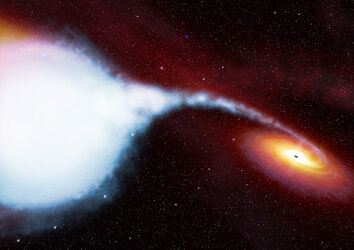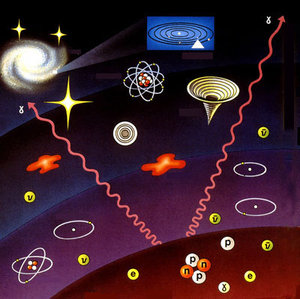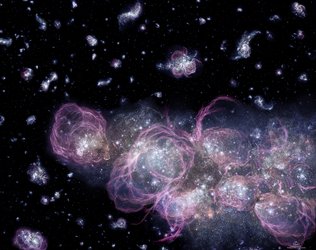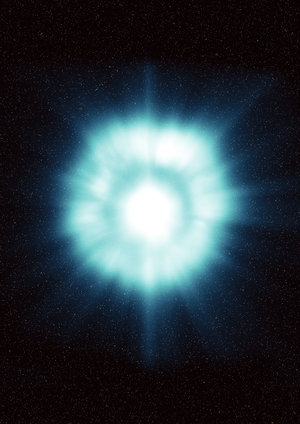Back to the future: An interview with Norbert Schartel
As a child, he was fascinated by the past. Now, as an adult, Norbert Schartel regularly looks into the future of science. He is Project Scientist on ESA’s XMM-Newton X-ray observatory.

Norbert Schartel
Project Scientist, XMM-Newton
Born: 20 October 1962 in Darmstadt, Germany
Norbert completed his Diploma in Physics in June 1990 at the Technische Hochschule, Darmstadt, specialising in General Relativity.
He then received his PhD in Physics from the Ludwig-Maximilians University in Munich for the research on X-ray spectra of quasars he performed at the Max-Planck-Institut für extraterrestrische Physik in Garching.
He joined ESA in 1994 as a resident astronomer at ESA’s Satellite Tracking Station in Madrid, known as VILSPA, where he worked on the International Ultraviolet Explorer, a space observatory for ultraviolet spectrometry which was launched in 1978. Norbert joined the XMM-Newton team in 1998 before being appointed Project Scientist in 2004.
He will be overseeing some of the most exciting discoveries of our generation, at a time when scientists are making amazing observations of binary stars and are starting to measure the masses of black holes.
Norbert currently lives near Madrid in Spain, where he still enjoys reading about Roman archaeology, as well as the middle ages in Germany.
We are just starting to make some very exciting observations simultaneously with ESA’s Integral spacecraft.
ESA: What is your role, as Project Scientist on XMM-Newton?
Norbert Schartel
My main function is to be the interface between XMM-Newton and the science community. My ultimate goal is that the best science possible comes out of the mission, and to achieve this we ask scientists from around the world what targets the spacecraft should observe. We get up to 10 times as many requests as XMM-Newton has time to observe.
Although I don’t make the final decisions, I have to ensure that it is a very fair process when the science experts discuss all the proposals and choose the best ones. Of course, the process means that some people will be very disappointed, since every scientist only sees their own proposal, but this is unavoidable. In the end, the spacecraft has to look at what makes the most interesting target.
In archaeology, you excavate a tiny object and, from that tiny object, reconstruct the evolution of a part of history. We are doing a very similar thing with XMM-Newton.
ESA: What are the most interesting targets for XMM-Newton at the moment?
Norbert Schartel
Well, we are just starting to make some very exciting observations simultaneously with ESA’s Integral spacecraft. Integral detects radiation from extremely violent events across our Universe, but we don’t know exactly what the source of the radiation might be: whether it is an exploding star, colliding neutron stars or, most interestingly, a binary star sytem where an ordinary star similar to our Sun orbits around a compact star, which could be a black hole, a neutron star or a white dwarf.
The compact star drags gas from its companion, which falls in a gravitational trap in the form of a disc and gets extremely hot, so hot that it emits X-rays, which XMM-Newton can measure. By following Integral, we can track down the source of the radiation and, by observing the X-rays it produces, we can determine its physical details and can conclude whether it is in or outside our galaxy, or ‘extragalactic’. These observations will eventually help us to answer some important questions about these dramatic phenomena.
Imagine somebody living in the Sahara desert coming across a tiny spring of water. Suppose that from this discovery they can picture the possibility that oceans can exist.
ESA: You work from a special ESA Science facility located near Madrid, Spain, while XMM-Newton is controlled from Darmstadt, Germany. Does this make things difficult?
Norbert Schartel
Ever since I started working for ESA, I have always been at VILSPA. Apart from the fact that Spain is a wonderful place to work, as the climate is so good you can sit outside in the evenings during most of the year, I find working closely with the technical operations people in Darmstadt works extremely well.
Admittedly, you have to call your colleagues on the phone, rather than see them face to face, but this does not affect the speed with which we can achieve our aims. For example, if XMM-Newton has the chance to observe a supernova explosion, which occurs at the end of a star’s lifetime, we have to get the spacecraft in a good position as soon as we can because a supernova decays very quickly, so the earlier we get there the better.
It used to take us over a week to restructure the computer program governing a satellite position in order to change it. Nowadays, we can achieve this in almost real time via the internet.
15 years ago, black holes were something you could only measure using mathematics – nobody thought we would ever be able to measure them by detecting X-rays around them.
ESA: What drives you in your job?
Norbert Schartel
The biggest driver for me is that XMM-Newton gets the best output that it possibly can. In fact, I get very excited about the progress we have made so far and what is to come. When I started working in the field 15 years ago, black holes were something you could only measure using mathematics – nobody thought we would ever be able to measure them by detecting X-rays around them.
If you can imagine somebody living in the middle of the Sahara desert, who one day comes across a tiny spring of water. Suppose that from this discovery they can picture the possibility that oceans can exist.
That is the kind of vision that scientists in my field had to have. And now we are at a stage where XMM-Newton can use its observations to estimate the mass of a black hole with virtually laboratory precision. These are dramatic changes.
In many ways, it is not surprising that I have ended up working with XMM-Newton. As a child, I was fascinated by archaeology and worked every weekend on one dig or another. In archaeology, you can make an excavation of a tiny object and, from that tiny object, try to reconstruct the evolution of a part of history around it. We are doing a very similar thing with XMM-Newton, as we are finding out about the spectacular evolution of our Universe from the data that we gather.
ESA: What advice would you give somebody who is interested in working in a similar field to you?
Norbert Schartel
It is undoubtedly a very fascinating area to work in. However, I would say to people that opportunities for jobs are restricted. It is not like being a doctor, where you can find a job in every town. In this field, if you want to work in a good institute, you have to be prepared to move around to do so.







